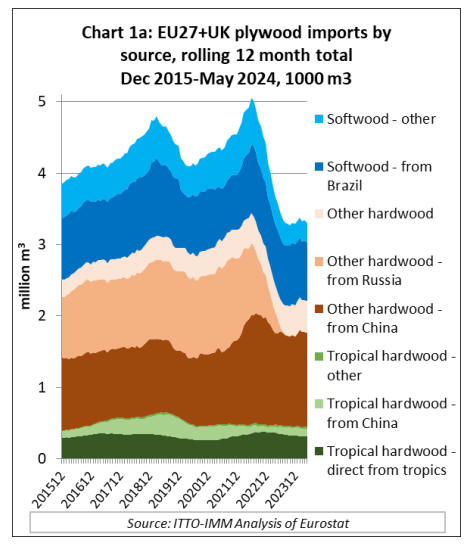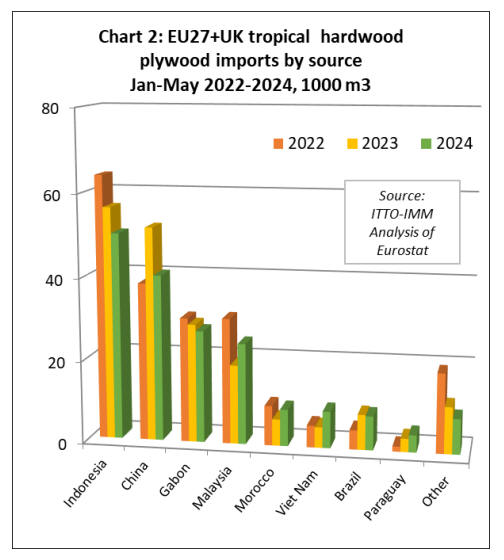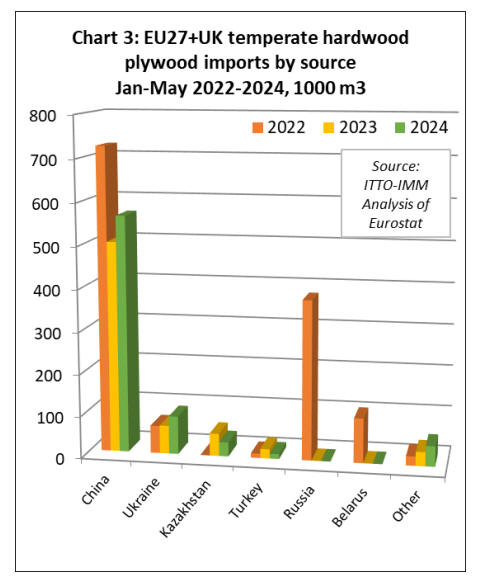|
Report from
Europe
European plywood production and imports at record
low
Total EU+UK imports of plywood from outside the region
in 2023 were 3.29 million cu.m, down 26% compared to
the previous year and only just exceeding the record low
of 3.1 million cu.m in 2009 during the global financial
crises.
The decline in 2023 felt even more dramatic as it followed
on from two years in 2021 and 2022 when imports were at
record levels averaging 4.5 million cu.m per annum (Chart
1a).

EU+UK imports of plywood from outside the region have
remained weak in 2024. In the first five months of the
year, total imports were 1.58 million cu.m, just 1% more
than the same period in 2023.
Imports of tropical plywood were down 5% to 180,600
cu.m and imports of softwood plywood were down 6% to
652,000 cu.m. However, these declines were offset by a
10% rise in imports of temperate hardwood plywood to
748,800 cu.m.
Despite the slight rise this year, EU+UK imports of
temperate hardwood plywood remain well down on levels
prevailing before Russia’s invasion of Ukraine in February
2022 and the subsequent imposition of economic sanctions
on Russia and Belorussia by the EU and UK, including a
total ban on all imports of timber products from both
countries.
Due to slowing economic conditions in Europe for the
second half of 2022 onwards, the anticipated surge in
plywood imports into Europe from alternative supply
countries following the removal of Russian and
Belorussian products from the market has been much less
dramatic than expected.
By far the biggest gain in market share has been made by
temperate hardwood plywood from China (Chart 1b).
There was also a surge in birch plywood imports into the
EU from Kazakhstan in 2023, raising immediate concerns
that some European importers were deliberately
circumventing the sanctions by sourcing Russian birch
plywood from third countries.

EU domestic plywood manufacturers were unable to
increase production in response to the supply gap that
opened following the sanctions on Russian and
Belorussian products.
Data from the European Panels Federation indicates that
total EU plywood production fell 2.5% from 3.2 million
cu.m in 2021 to 3.1 million cu.m in 2022 and then a
further 15% to just 2.6 million cu.m in 2023.
In fact, the level of EU production last year was
unprecedented, being the lowest ever recorded and only
about half the volume of nearly 5 million cu.m per annum
prevailing before the COVID pandemic.
This year, EU+UK imports of tropical hardwood plywood
direct from tropical countries have held up better than
imports of plywood faced with tropical hardwood from
China. In the first five months of this year, imports from
China into the European region, which are mainly destined
for the UK, decreased 22% to 40,300 cu.m.
In contrast, imports direct from tropical countries during
the period were 129,000 cu.m, just 1% less than the same
period in 2023.
Although imports from Indonesia fell 11% to 50,100 cu.m
and were down 5% to 27,100 cu.m from Gabon, there was
a strong 27% rebound in imports from Malaysia to 24,400
cu.m, while imports from Vietnam increased 78% to 8,900
cu.m and imports from Paraguay were up 29% to 4,100
cu.m (Chart 2).

In the first five months of this year, EU+UK plywood
imports of temperate hardwood plywood increased 10% to
748,800 cu.m. The gains were mainly due to imports from
China and Ukraine, which were 564,100 cu.m and 90,800
cu.m in the January to May period this year, respectively
12% and 35% more than the same period in 2023.
Imports of temperate hardwood plywood from Kazakhstan
were down 37% to 33,700 cu.m while those from Turkey
fell 48% to 11,500 cu.m in the first five months of this
year (Chart 3).

The decline in European imports from Kazakhstan and
Turkey comes at a time when the European Commission is
extending anti-dumping measures on imports of birch
plywood, previously applied to Russian products, to
imports from the two countries.
The EC announced the extension on 14 May this year
following an EC investigation which concluded that EU
anti-dumping duties on imports of birch plywood from
Russia were being circumvented by imports transhipped
from Russia to Kazakhstan and Turkey, or sent for final
completion to these countries, preceding shipment of the
finished product to the EU.
In the first five months of this year, the EU+UK region
imported 652,000 cu.m of softwood plywood, 6% less
than the same period in 2023. The decline in imports was
driven mainly by Brazilian products, for which imports
fell 7% to 524,000 cu.m.
Imports from China also declined, by 6% to 33,000 cu.m.
Imports from South Africa increased by 10% to 8,000
cu.m. Imports from Chile were stable at 63,000 cu.m.

European plywood importers look to 2025 for market
upturn
Leading European plywood importers have forecast trade
to be on a level with 2023 or be only marginally up this
year. They are not expecting a more robust recovery until
next year.
A UK importer-distributor of temperate and tropical
plywood said their market ‘still feels depressed’. “We
expect 2024 to remain flat,” they said. “We don’t
anticipate much change until interest rates fall and house
building kick starts the UK economy. We just hope that
the new UK government lives up to its pledge to back
construction to build 1.5 million new dwellings in the next
five years.”
An EU-based importer, who described their business as
‘heavily dependent on construction’, said that some of
their national plywood markets have been doing better
than others.
“The Netherlands and UK have performed slightly below
2023 so far but are picking up slowly and expected to be
in line with last year at the end of 2024,” they said.
“However, France and Germany have performed below
expectation.” A key concern for European importers has
been the hike in freight rates.
“Part of the increase is justifiably attributed to the attacks
on shipping in the Red Sea, leading to vessels having to
avoid the Suez Canal and take the long route around the
tip of Africa,” said an EU importer-distributor. “But the
feeling is that some shipping lines are taking advantage of
the situation and increasing rates over and above what is
justified.”
“This situation has been causing real issues for us,” said a
UK importer. “A 40-ft container from Southeast Asia had
fallen from the peaks we saw in the pandemic to around
US$1,000 in December 2023, but in 2024 rates returned to
above US$10,000 and we’re now paying around
US$7,500. We expect the situation to remain challenging
until rates go down below US$5,000 a box, but we don’t
anticipate that happening until 2025.”
Plywood prices on a firming trend
“Far East and China FOB rates haven’t changed a lot, but
prices have of course been driven by the logistic costs,”
said an EU importer-distributor. “For Africa and South
America logistic cost have remained more stable, but FOB
rates increased throughout Q1and Q2 this year.”
A UK importer qualified this by saying that Brazilian
plywood prices were still below their previous peak, kept
down by cuts in the price for competing EU-made OSB
which manufacturers have made to ‘combat imports’.
Another European importer said their best performers so
far this year have been ‘Chinese commodity and high
quality plywood’, okoumé plywood and eucalyptus
plywood from South America.
“We’ve also sold some volumes of tropical hardwood
plywood from Indonesia, and some marine plywood into
the UK from Malaysia and Indonesia,” they said.
Another importer reported an increase in offers of
rubberwood and acacia plywood from Malaysia and
Indonesia.
Following the UK and EU embargo on Russian and
Belarusian timber and wood products, one UK importer
said birch plywood of unknown provenance was coming
into the market.
“We can’t comment on its true origins, but we hope it is
being fully checked by the UK Office of Product Safety
and Standards [which polices legality of timber imports],”
they said.
Some importers say that the ban on Russian birch plywood
in the EU is actually opening up opportunities.
“It has had a positive effect on our business as we’ve been
able to replace birch with high quality film-faced plywood
from China with better margins,” said an EU importer.
No major availability issues are being reported by
importers. “We experienced some shortness in supply in
Q1 2024 due to logistics issues from China and the rest of
Southeast Asia, but overall, it’s been sufficient to meet
demand,” said an EU importer.
A continuing concern of the EU plywood sector is the EU
Deforestation Regulation (EUDR), which comes into force
at the end of 2024. It will require that companies which
place timber and wood products from all origins on the EU
market undertake due diligence to ensure their production
is not implicated in deforestation or forest degradation.
They will also have to provide geolocation coordinates for
the origins of products.
“It will create huge administrative burdens,” said one
importer. “We are working with a third party to ensure
compliance, as we did under the previous EU Timber
Regulation (EUTR), and we expect the cost of this to go
up 40% to 50% under the EUDR compared to under the
EUTR. We also think the EUDR may lead to some
suppliers looking to alternative markets to the EU,
including some Chinese suppliers. There have been calls
from the EU timber sector for introduction of the
Regulation to be delayed to give business a longer
transition period, and we would support that.”
That prospects for 2025 are looking more promising seems
to be the general view among European importers.
“While the rest of 2024 is looking unexciting, there are
signs things will be better in 2025,” said a UK importer.
“Once construction picks up, as is predicted, everything
will improve from there.”
“Increased prices as of Q2 into Q3 and Q4 this year will
help us improve turnover and margins in 2024, and we
have seen some increase in import volumes, although that
may be the follow on from logistics issues for Far East and
Chinese cargoes we saw earlier in the year,” said an EU
importer. “It remains to be seen how stocks will evolve in
Q4. But we see further market improvement from Q2 2025
and for the second part of the year we are more
optimistic.”
Europe’s wood panel manufacturing sector had a
difficult 2023 - anticipates improvement this year
According to the European Panel Federation’s (EPF) latest
Annual Report, Europe’s wood panel manufacturing sector
had a difficult 2023. This year the EPF expects to see a
degree of improvement in sales, however, a stronger
upturn is not anticipated until 2025.
A summary of the EPF report, covering market
development and European panel producer performance
through 2023/24 was presented at the EPF agm in Riga in
June.
The event was reported by Wood Based Panels
International as attracting an audience of 180, drawn from
across particleboard, plywood, MDF, OSB, hardboard and
softboard industries. It underlined the EPF’s
‘representation of all panel types and the whole of
Europe’, said WBPI, with the organisation reporting
market statistics for the EU 27, UK and EFTA and some
‘all-Europe figures’, including those of Belarus, Russia,
Turkey and Ukraine.
Delegates heard that Europe’s total wood panel production
declined by 6.3% in 2023 to 56.5 million cu.m, hit by poor
construction and furniture production. European wood
furniture output was 8% down and consumption11% in
2023 after declines of 11% and 12% respectively in 2022.
Furniture production in the EU27+UK was valued at
€39.7bn and consumption at €39.4bn. Euroconstruct
reports that overall construction output last year in the 19
countries it covers was down 1.4%.
According to the EPF report, last year’s contraction in
European panel production followed a 7.7% decline in
2022 after the post-pandemic home improvement surge
resulted in record output the year before.
Oriented strand board (OSB) was the only panel product
area that saw production growth in 2023, with an
EU27/UK/EFTA increase of 2% to 6.6 million cu.m,
versus 6.5 million cu.m in 2022.
Particleboard output was down 5% in 2023 at 30.9 million
cu.m, while MDF production fell 11% to 11.1 million
cu.m. After growing significantly in recent years,
softboard production – mainly for the insulation sector -
was 6% lower in 2023 at 4.8 million cu.m. Down most
sharply was hardboard production, which was 17% lower
than 2022 at 400,000 cu.m. Plywood manufacture fell 15%
to 2.6 million cu.m.
The EPF reports that furniture production remained the
biggest consumer of European wood panel products last
year. But with furniture sales falling due to the uncertain
economic situation, high interest rates and inflation and
consequently decreased consumer confidence, the sector
accounted for 47% of total panel output, down from 48%
in 2022. The building industry accounted for 39%, while
3% went to the packaging sector and 11% to other
applications.
The EPF projects that 2024 will see a return to market
growth, but with total European wood panel output up
only about 500,000 to 600,000 cu.m at 31.5 million cu.m.
OSB output is forecast to rise 150,000 cu.m to 6.75
million cu.m, with MDF production up around 90,000
cu.m.
Plywood production is also expected to show a slight rise.
EPF forecasts that EU27 output will be up 40,000 cu.m,
with a total Europe production increase (including output
from Belarus, Ukraine, Russia and Turkey) of 50,000
cu.m.
Discussion topics at the EPF AGM also included the
European Commission’s communication on ‘Building the
future with nature’ and its potential impact on the wood
panel sector. It states that biotechnology and
biomanufacturing are among the most promising
technological areas for the EU in the 21st century, with the
capacity to modernise and advance forestry and bio-based
materials sectors, among other industries.
Katharina Knapton-Vierlich, Head of Unit at the EC
Directorate General which supports growth and resilience
of the EU economy detailed possible next steps for
developing the bio-based materials sector. These include
creating an EU biotech hub, introducing labelling for bio-
based materials, and revising Product Environmental
Footprint rules to ensure fair comparisons between bio-
based and fossil- based products.
See: https://europanels.org/annual-report/
and
https://ec.europa.eu/commission/presscorner/detail/en/STATEM
ENT_24_1610
and
https://www.wbpionline.com/
|